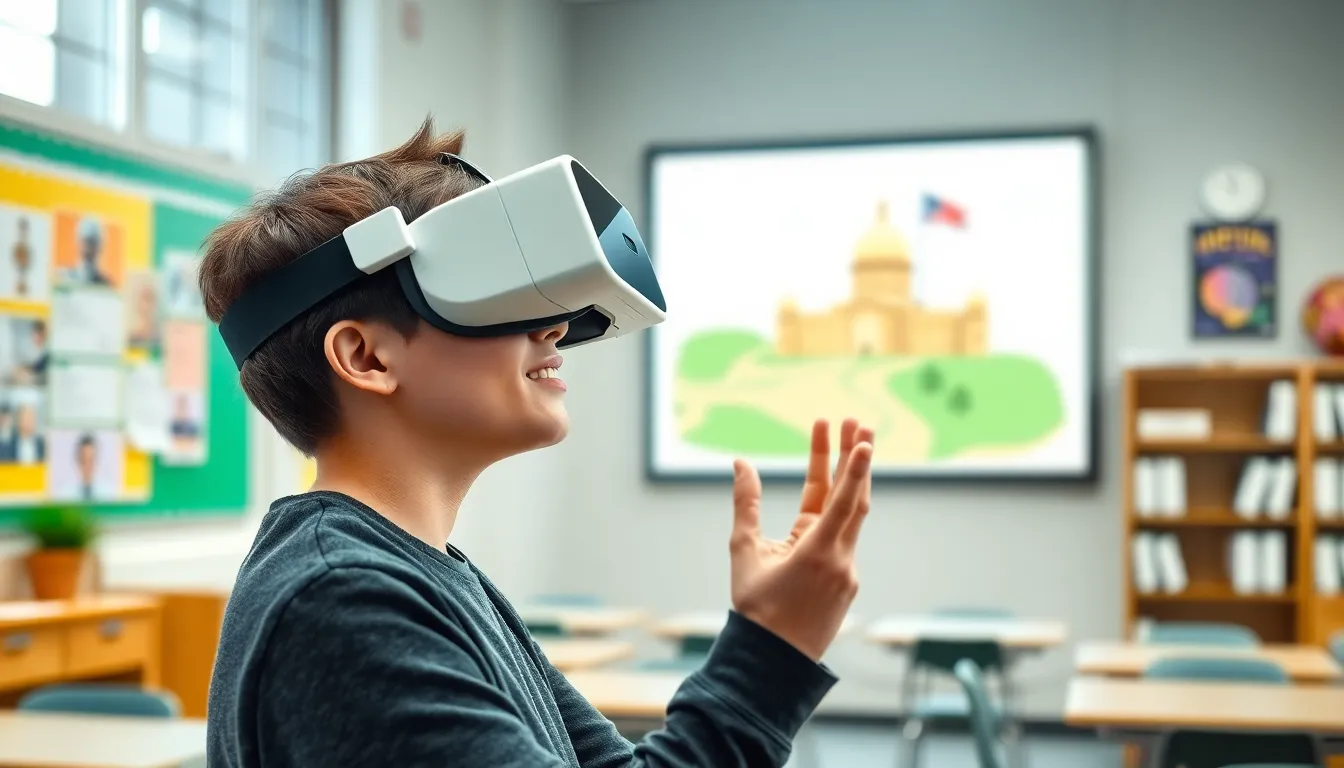Imagine diving into a world where history lessons come alive and science experiments happen right in your living room. Educational VR apps are transforming the way learners engage with knowledge, making studying feel less like a chore and more like an adventure. Who wouldn’t want to explore ancient ruins or conduct virtual chemistry experiments without the risk of blowing anything up?
Table of Contents
ToggleOverview of Educational VR Apps
Educational VR apps revolutionize the learning experience by immersing users in interactive environments. Students engage in dynamic simulations that enhance understanding of complex subjects. For example, history lessons come alive as learners virtually visit ancient civilizations, allowing for a more profound appreciation of cultural heritage. Science experiments become safe, hands-on activities where users can explore chemical reactions or the principles of physics in controlled settings.
Many educational VR apps emphasize personalized learning paths. These platforms adapt to individual skill levels, promoting mastery of subjects at one’s own pace. User data supports this method, as it shows improved retention rates and higher engagement scores compared to traditional learning methods.
Applications like Google Expeditions and Labster offer extensive virtual field trips and science labs. With Google Expeditions, teachers guide students through interactive tours, while Labster provides realistic lab experiences tailored for specific scientific concepts. Such immersive experiences foster curiosity, encouraging learners to explore and experiment without traditional constraints.
Collaborative features enhance group learning, allowing multiple users to interact within the same virtual space. This aspect fosters teamwork and communication skills, essential for real-world applications. Moreover, researchers indicate that VR encourages creativity in problem-solving and critical-thinking exercises.
As educational institutions increasingly incorporate VR, the accessibility of technology improves. Virtual reality headsets are becoming more affordable, enabling schools to invest in innovative educational tools. Ultimately, the fusion of technology and education through VR apps helps make learning an engaging adventure for all.
Key Features of Educational VR Apps

Educational VR apps offer users a range of features that enhance their learning experiences. Key among these features are immersive learning experiences and interactive simulations.
Immersive Learning Experiences
Immersive learning experiences transport users into realistic environments. Learners can fully engage with historical sites or explore complex scientific processes. Virtual settings enable exploration of ancient civilizations, enriching cultural understanding. These experiences make otherwise dull subjects lively and engaging. It becomes easier for users to grasp intricate concepts because of vivid visualizations that bring learning materials to life. Users interact with 3D models that illustrate physics principles effectively. Such environments foster deeper connections with the material, ensuring lasting retention of knowledge.
Interactive Simulations
Interactive simulations provide hands-on experiences that enhance learning outcomes. Users experiment in safe, controlled settings without real-world risks. For example, they can conduct chemistry experiments or perform medical procedures virtually. Simulations allow for trial and error, which encourages curiosity and boosts confidence among learners. Engaging in these activities develops critical thinking and problem-solving skills. Each interaction reinforces understanding, making complex subjects more approachable. Apps like Labster exemplify how interactive scenarios promote experiential learning. Overall, these simulations transform traditional educational methods, leading to deeper comprehension and retention.
Benefits of Using Educational VR Apps
Educational VR apps significantly enhance the learning experience through various benefits. These advantages include increased engagement and improved retention of information, which are vital for effective education.
Enhanced Engagement
Engagement levels rise dramatically with the use of educational VR apps. They immerse learners in interactive environments, capturing attention more effectively than traditional methods. Users often find themselves exploring historical landmarks or performing science experiments as though they’re part of the action. This hands-on approach encourages curiosity and motivation, resulting in a more enjoyable learning process. Many studies indicate that students who use VR technology collaborate better and participate actively in lessons. The excitement of discovery in VR can spark a deeper interest in subjects, leading to richer educational experiences.
Better Retention of Information
Retention rates improve significantly via educational VR apps. An immersive format allows learners to visualize and experience complex concepts directly. When users explore simulations, they forge connections that lead to lasting memories. Engaging with material in a practical, hands-on manner fosters understanding and recall. Research shows that learners retain information more effectively after participating in VR experiences than through traditional lecture methods. The ability to revisit simulations reinforces knowledge, ensuring that educational content remains fresh in the learners’ minds. Overall, enhanced retention not only benefits individuals academically but also equips them with critical skills for real-world applications.
Popular Educational VR Apps
Several educational VR apps stand out, each offering unique features that enhance learning. The following apps exemplify how virtual reality revolutionizes educational experiences.
App 1: Google Expeditions
Google Expeditions allows users to embark on virtual field trips across the globe. Students can explore historical landmarks, cultural sites, and even outer space, all from the classroom. This app features 360-degree images and videos, immersing learners in vivid environments. Teachers can guide students on structured tours or allow independent exploration. By fostering curiosity, Google Expeditions connects abstract concepts to real-world experiences, enhancing understanding and engagement.
App 2: Labster
Labster brings laboratory experiences to life through realistic simulations. This app offers a wide range of scientific experiments across fields like biology and chemistry. With intuitive interfaces, learners can conduct experiments safely without real-world risks. Users engage with complex topics, which deepens comprehension of scientific principles. Labster also tracks progress, enabling tailored learning paths. This adaptability helps individuals master skills at their own pace, leading to improved retention of information and practical application in real-world scenarios.
Future Trends in Educational VR Apps
Emerging technologies continue to shape educational VR apps, enhancing their effectiveness in learning. Increased use of artificial intelligence within these apps personalizes user experiences more than ever. By analyzing individual learner data, AI can adapt content and recommend activities, catering to diverse skill levels and learning speeds effectively.
Moreover, cloud-based VR technology is expanding access, allowing users to connect seamlessly across devices. This trend encourages collaborative learning, as students can work together in virtual spaces regardless of their geographical locations. With real-time interaction, users can engage in discussions and problem-solving exercises, fostering a sense of community.
Immersive storytelling is gaining traction as well, capturing learners’ imaginations. By integrating narratives into educational content, apps can enhance engagement and retention, making complex subjects relatable and exciting. For example, history lessons may unfold as engaging stories, transporting users to different eras and events for a richer understanding.
In addition, gamification elements are increasingly present in these applications. Incorporating game mechanics such as points, badges, and leaderboards motivates students to complete tasks and reinforces learning through competition. This integration leads to higher engagement levels and a more interactive learning experience.
Finally, the development of more affordable and lightweight VR headsets continues to improve accessibility. With budget-friendly options available, more educational institutions can adopt VR technologies, paving the way for widespread implementation in classrooms. As these trends evolve, educational VR apps are set to revolutionize how students learn and interact with information.
Educational VR apps are reshaping the landscape of learning. By immersing students in interactive environments they foster engagement and enhance retention. These tools not only make complex subjects accessible but also promote collaboration and critical thinking.
As technology evolves more learners will benefit from the enriched experiences VR offers. The integration of AI and cloud-based solutions will further personalize education making it more effective. With increasing accessibility through affordable headsets the future of learning is bright.
Embracing these innovations can lead to a more dynamic and engaging educational experience for students everywhere.









